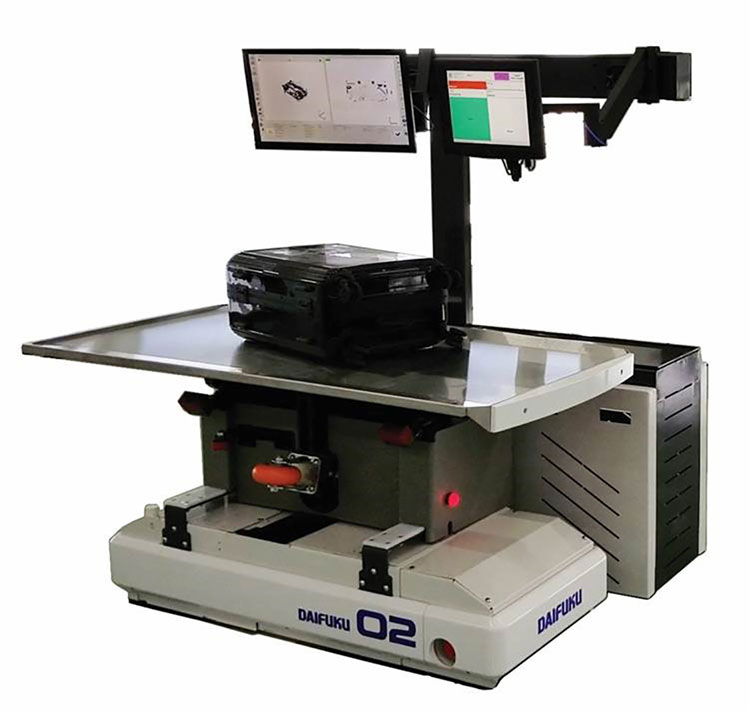Daifuku baggage product showcase: Automating the industry
- Like
- Digg
- Del
- Tumblr
- VKontakte
- Buffer
- Love This
- Odnoklassniki
- Meneame
- Blogger
- Amazon
- Yahoo Mail
- Gmail
- AOL
- Newsvine
- HackerNews
- Evernote
- MySpace
- Mail.ru
- Viadeo
- Line
- Comments
- Yummly
- SMS
- Viber
- Telegram
- Subscribe
- Skype
- Facebook Messenger
- Kakao
- LiveJournal
- Yammer
- Edgar
- Fintel
- Mix
- Instapaper
- Copy Link
Posted: 15 March 2019 | Joe Emery | No comments yet
Joe Emery, Senior Sales Application Engineer at the Jervis B. Webb Company of Daifuku Airport Technologies, discusses the mobile inspection table, and how it is revolutionising the baggage handling space.
The Mobile Inspection Table (MIT) is a stainless-steel inspection table mounted atop an automated guided vehicle (AGV) that is being used in checked bag resolution areas (CBRA) within airport baggage handling systems across the United States. Bags that require manual screening by the transportation security officer (TSO) are automatically loaded on to an MIT and are directed to an inspection station where the TSO carries out a manual inspection of the bag. Once the bag inspection is complete, the MIT automatically travels to the appropriate unload station and reintroduces the bag to the conveyor system via a mechanical tilt mechanism.
What are the benefits of MIT over the more traditional conveyer and static table set up?
The largest benefit of the MIT are the ergonomics brought forth by automatic delivery and take-away for checked baggage. You see often in baggage systems where, at a minimum, the TSO must drag bags from the conveyor belt on to the conveyor, and then push on to a takeaway conveyor after inspection is completed. In some older systems, each bag is lifted and carried to the inspection station from the input conveyor. The MIT follows the goods to person methodology and allows the TSO to focus on bag inspection instead of transporting the bag and removes and physical work to get the bag to the inspection station. The MIT is ideal for the TSA’s no lifting policy. The MIT’s ergonomically-friendly design has greatly reduced injuries associated with more manual lifting methods.
Other benefits include significant noise reduction, improved room access and egress, reduced downtime due to the ability to take a single MIT out of the system for repair during an outage and eliminating a single point of failure, and a LEED enabling energy savings of greater than 60 per cent when compared to a traditional conveyor system.

There has been excitement in the industry since we first unveiled the MIT as an available product in 2015. AGVs are a well‑proven technology with uses in several industries (such as automotive factories and distribution warehouses) and Jervis B. Webb has been providing AGVs since 1962. With such a strong track record, it was not difficult to get the industry on board using AGVs in an airport application.
Our first deployment was a small loop provided to the TSA Systems Integration Facility to allow the TSOs to become comfortable with the technology as it would be new to most operators, and they are the real end user in any MIT system. This was also a great opportunity to receive feedback and include the suggestions prior to implementing our first live MIT system in 2016 at Detroit Metropolitan Airport in the North Terminal. As of January 2019, four airports have a combined six MIT systems and three more systems are currently in installation.
What other applications do you foresee with this technology?
Webb has been working with several consultants and airlines about approaching applications outside of the CBRA that can utilise not only the MIT, but other AGV applications within the airport grounds. Now airports are becoming more familiar with the technology, we are being approached with applications that we never even considered. Some early possibilities are in early bag storage, and oversized handling applications.
There is certainly opportunity across the entire airport for AGV technology. The next time you sit at the gate ready to board your flight, look out the window and you’ll notice a countless number of vehicles used for day-to-day operations. With the recent technology advancements and the continuous growth of autonomous vehicles, it’s no longer a question of “if” all these airport vehicles can be autonomous, it’s now a question of “when”.
Issue
Related topics
Airside operations, Autonomous Technology, Baggage handling, Machinery, Terminal operations


















